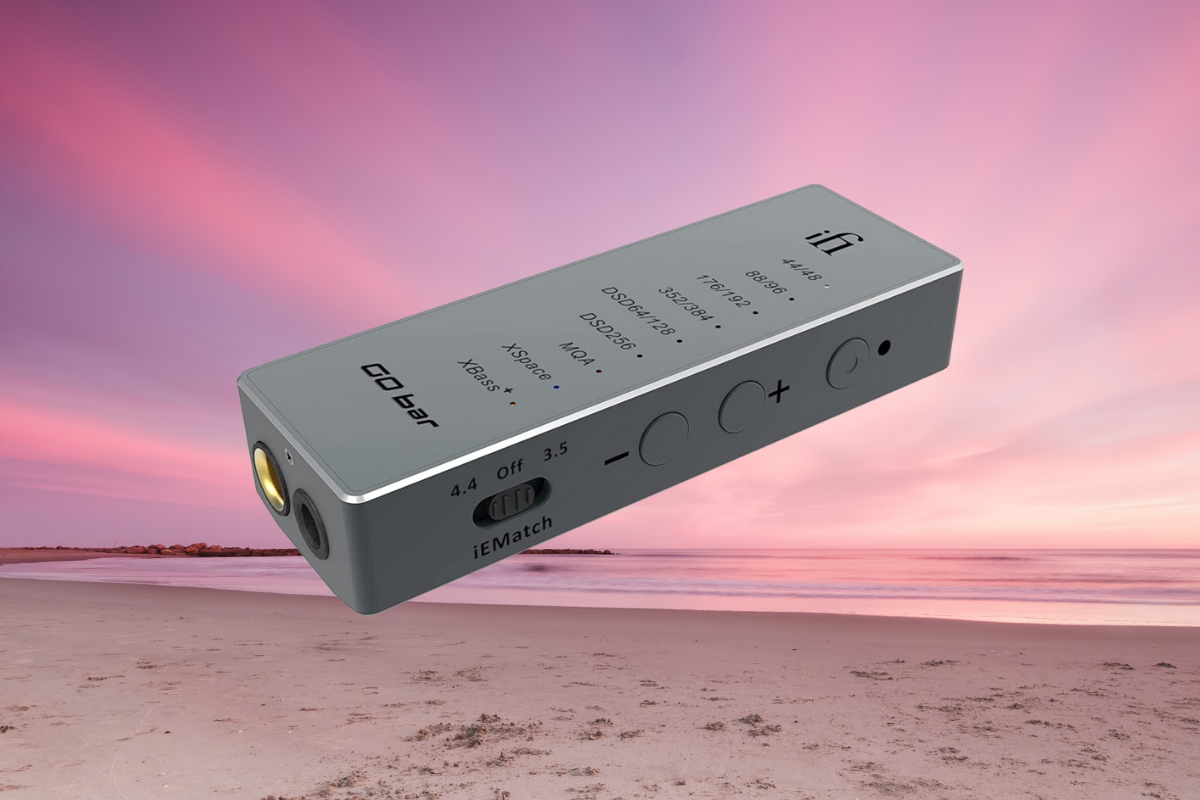TL;DR
If you’re looking for the most capable ultra-portable DAC/Amp combo, look no further.
Intro
I’m a big fan of iFi Audio’s DAC/Amp combos. It’s hard to beat their combination of power, build quality, and affordability. However, they’ve been missing one thing: an ultra-portable combo that could go toe to toe with something like AudioQuest’s Dragonfly DACs or similar products from Shanling or Hidizs.
This is a trendy market segment, so I’ve been very interested in seeing iFi’s take on such a product. Now it’s here. Ifi’s first true ultra-portable is called the iFi Audio Go bar. It retails for $329, putting it in direct competition with what we consider the king of the category, the $329 AudioQuest Dragonfly Cobalt.
While we love the Cobalt’s sound, iFi has positioned the Go bar as the most potent headphone amp for its size, with over ten times the power of the AudioQuest DAC. It also has about 15 times more power output than most other DAC/amps.
That makes it competitive with full-sized desktop amps power-wise. It also has a fully balanced output, which is quite rare for a DAC/amp combo its size.
So is the iFi Go bar the new premium ultra-portable DAC/amp to beat? Well, read on, and I’ll let you know the scoop!
Disclaimer: The iFi GO bar was sent to us by iFi Audio in exchange for an honest, unbiased review. The company gave no input regarding the content included in this evaluation. iFi Audio is a sponsor of Hifitrends.
Build/Features
When it comes to build quality, the iFi Go bar is solid, using a full aluminum alloy enclosure. It basically looks like a miniaturized version of iFi’s larger transportable DACs (think micro iDSD Signature), and it feels just as durable while still managing to be extremely lightweight.
Not only does it resemble many of its larger siblings, but it also provides much of the same functionality, like an actual balanced output (4.4mm), a Single-ended output (3.5mm), IE Match gain control and native DSD processing.

There’s also full MQA decoding on board, plus iFi’s popular XBass+ and XSpace analog-based sound effects. In addition, you can select between four digital filter settings (Bit-Perfect; no filter, Standard; the factory setting, Min. Phase, Gibbs Transient Optimised) to further tailor the sound.
On the outside of the Go bar’s metal enclosure are its function buttons, including a two-button volume control, a switch for the previously mentioned IE Match, and a setting button for the XBass+/XSpace effects.
The setting button will let you turn on either XBass+ or XSpace individually or both simultaneously with subsequent presses. Additionally, holding that same setting button down will let you select between the four previously mentioned digital filters.
The Go bar’s volume control works independently of its connected device, which is a pretty nice feature. The volume control is also quiet and precise, making it a pleasure to use. Conversely, you can also sync volume between the DAC and the connected device.

Moving over to the IE Match switch, it has three settings. First is “Off,” which sets the standard gain for both outputs. Then, by moving the button either left or right, you can select a lower gain setting for either the 3.5mm or 4.4mm output. The lower gain settings are meant for high-sensitivity IEMs and the like.
You also have a “Turbo” mode gain option, which gives you a considerable boost of +6dB for the most power-hungry headphones. This is accessed by pressing both volume buttons at the same time.
While you can drive pretty much any headphone with the standard gain, the “Turbo” mode is suitable for additional headroom on the most power-hungry headphones. I only had one headphone that needed it, and that was the Dan Clark Aeon Flow Closed.
On the bottom of the Go Bar is the format/sample rate LED indication, a row of LED lights that give you an easy-to-understand view of the type of file being processed. Below the sample rate LEDs are additional lights indicating the effect/filters in use.

The sample rate LEDs also display the volume level briefly while pressing the volume buttons. The volume indication ranges from no LEDs meaning zero volume, up to six LEDs which signifies max volume.
The Go bar’s headphone amp section has an output of up to 475mW into 32 ohms (balanced), which is insane for this size device. This makes it the most powerful ultra-portable DAC I’ve come across. I was able to use some pretty difficult-to-drive full-size headphones with this DAC/Amp, no problem.
The DAC section is based around a 32-bit Cirrus Logic DAC chipset, which allows the Go bar to support up to 32-bit/384kHz PCM, native DSD, along with the full MQA unfold. This guarantees you will get the best sound possible from MQA files, which is vital for those streaming TIDAL Masters music.

As usual, iFi also specs premium components for optimum sound, including a more robust processor and higher grade capacitors than you usually see in this category. A quick peek inside of this DAC/Amp shows the lengths iFi has gone to make this unit sound bigger than it is.
Furthermore, the Go bar has detachable cables so that you can switch between the included Lightning to USB-C cable for iOS devices or the included USB-C OTG cable for Android/PC/Mac devices.
By the way, you also get a USB-C to USB-A adapter for additional flexibility. There’s also a leather travel case included in the box to protect your DAC/Amp. The case also has room to hold a connection cable.
Sound
To get a good idea of what the iFi Go bar could do, I hooked it up to my HP Envy X360 laptop using the USB-C port. I then plugged in a pair of Hifiman Arya (Stealth Edition) headphones into the balanced input. I felt they would be detailed and neutral enough to let this DAC/Amp shine.
I played some hi-res music from Qobuz (Rediscover your music in studio quality with Hi-Res streaming and downloads on Qobuz. Get a free trial now.), using the pre-set “Standard” filter, which is described as having “modest filtering” along with “modest pre and post ringing.”
I found the Go bar to be a little analytical and flat sounding with the standard setting. There was some warmth, but it mainly stuck to the facts, giving it to you straight.

I heard a boost to the upper mids, which added presence and detail, but on the Arya, which has its own upper-mid boost, it was a little too much. Overall, I found things to be a little closed in and dull.
At that point, I checked out the other Digital filters and landed on the GTO option, which upsampled all tracks to 352/384kHz along with “minimum filtering, no pre-ringing, minimum post ringing.” With this filter, the upper mid boost was pulled down, and there was a little more warmth in the midbass.
With GTO on, I also liked the center mids’ openness and warmth, which made things sound a lot more natural than the “Standard” filter. Overall, things were just more lively.
Listening to “Heaven” by David Anthony and Algebra Blessett, I was pleased with the sweet detail and separation in the vocals and the richness of the strings. The dynamics coming through the Arya were terrific. The soundstage wasn’t as wide as I would’ve liked, but the imaging and focus were excellent.
That said, in GTO mode, the emphasis on the midbass could be distracting in some songs.
I was probably most impressed with the Go bar when using the “Bit-Perfect” or no-filter mode. It sounded the most organic, with no significant emphasis in any part of the audioband. The Go bar is the most balanced and has the least coloration in this mode. In my opinion, every unit should come pre-set to this option.
On the other hand, the GTO setting did sound a little more open and richer, so if that’s what you like, it’s not a bad option either.
Vs. Dragonfly Cobalt
Next, I made a quick A-B-A comparison with the AudioQuest Dragonfly Cobalt and the Go bar in “Bit Perfect” mode on the single-ended jack. It was no contest. The Dragonfly had nowhere near the resolution of the Go bar, which in turn, had a much more credible presentation.
It’s not that the Cobalt didn’t sound good, but things were just much more fleshed out with the iFi Go bar.

I felt like I was hearing everything there was to hear through the iFi DAC, while I felt I was missing a lot of the audibility and directional cues when listening to the Cobalt. The Go bar also had a remarkable amount of headroom over the Audioquest DAC.
The Wrap Up

With the Go bar, iFi Audio set out to make the most potent and capable ultra-portable DAC/Amp combo. Consequently, after putting it through its paces, I have to say iFi has knocked it out of the park.
While it’s just a touch larger than the competition, there is no other USB DAC/Amp in the ultra-portable category with the same power, features, and refined sound quality. As a result, this product, which is about the size of a pack of gum, can competently drive flagship headphones, a fact that changes the game.
If I had any issue with the Go bar, it would be with the “standard” pre-set digital filter. I found it a little hard in the upper mids, which means it won’t play nice with all headphones. On the other hand, I found the “Bit-Perfect” and “GTO” filters to be more universal, meaning they will sound better with more headphones.
That said, if you’re looking to get a pocket-sized DAC/Amp combo that can hold its own with desktop units, you need to pick up a Go bar. Right now. It’s a must-have for the road warriors.
Hifitrends is reader-supported. When you purchase through links on our site, we may earn an affiliate commission. Prices are subject to change at any time.

I’m an audio writer who started as a young audio salesman/consumer electronics professional back in the late 90s. That’s where I discovered the magic of 2-Channel sound. My hunger for great sound has led me on a delightful music quest that continues today.



Leave a Reply